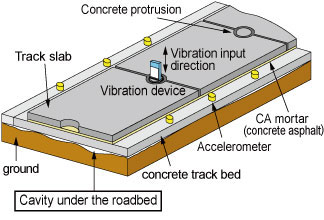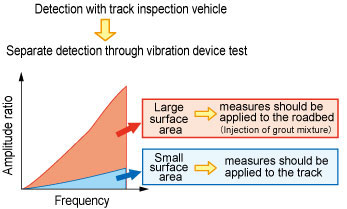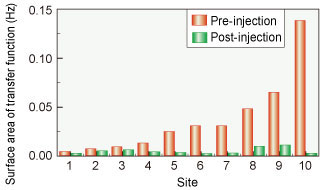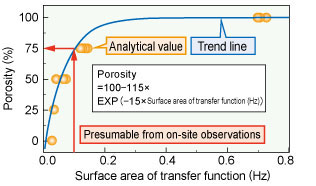7. Method for diagnosing condition of concrete roadbed in tunnels
Repeated loading from passing trains on slab track in tunnels with no invert can cause subsidence of the track bed leading to concrete track bed deformation and track irregularity (Figure 1). These problems can be detected through abnormal track geometry readings, however, up until now it has been very difficult to determine whether these problems arise because of the track bed or the track itself.
A method was therefore developed to diagnose the primary cause of track bed subsidence, by obtaining the transfer function (the ratios of the concrete track bed response frequency amplitudes obtained for each vibration frequency input to the vibrator) surface areas (in terms of ease of oscillation) obtained from excitation tests on a concrete track bed, which were used as indices, where larger values indicate the primary cause is located on the track bed side, while smaller values show that it is on the track side (Figure 2).
Application of the method to an actual tunnel, and vibration test results from before and after injection of the material were applied to cavities under the track bed concrete confirming the effectiveness of the proposed system (Figure 3).
A numerical analysis model was built to reproduce these phenomena. It was found that there was a good correlation between the transfer function surface area of the concrete obtained during excitation tests and the rate of cavity occurrence directly beneath the concrete track bed. This leads to the conclusion that it is possible to detect cavities directly beneath the concrete track bed from on-site measured results (Figure 4).
Other Contents
- 1. Seismic ground motion simulator applicable to M9 earthquakes
- 2. Seismic Hazard simulator for railways
- 3. Early warning system employing ocean bottom seismometer data
- 4. Development of Railway Embankment Structures Resistant to severe Earthquakes and Prolonged Overflows caused by Tsunamis
- 5. Measures against buckling of ballasted track during earthquakes
- 6. Disaster Hazard Mapping Technology
- 7. Method for diagnosing condition of concrete roadbed in tunnels
- 8. Analytical method for evaluating carbody safety aimed at reducing passenger injury in case of level crossing collisions
- 9. Bogie to control decrement in wheel load
- 10. Mechanical pneumatic steering system with failsafe function
- 11. Gear oil for Shinkansen trains with improved startability in low temperature conditions
- 12. Process to select appropriate sounds to convey in-cab driver alerts
- 13. Training in communication techniques for train dispatchers in disrupted situations
- 1. Seismic ground motion simulator applicable to M9 earthquakes
- 2. Seismic Hazard simulator for railways
- 3. Early warning system employing ocean bottom seismometer data
- 4. Development of Railway Embankment Structures Resistant to severe Earthquakes and Prolonged Overflows caused by Tsunamis
- 5. Measures against buckling of ballasted track during earthquakes
- 6. Disaster Hazard Mapping Technology
- 7. Method for diagnosing condition of concrete roadbed in tunnels
- 8. Analytical method for evaluating carbody safety aimed at reducing passenger injury in case of level crossing collisions
- 9. Bogie to control decrement in wheel load
- 10. Mechanical pneumatic steering system with failsafe function
- 11. Gear oil for Shinkansen trains with improved startability in low temperature conditions
- 12. Process to select appropriate sounds to convey in-cab driver alerts
- 13. Training in communication techniques for train dispatchers in disrupted situations




